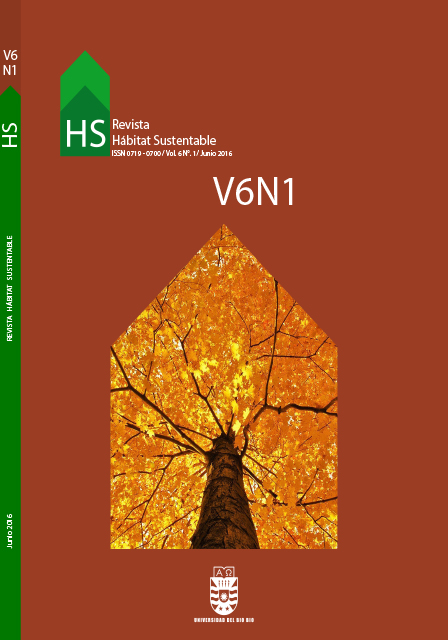The incorporation of carbon footprint and ecological footprint into construction cost databases: A case study of a development project in Écija, Spain
DOI:
https://doi.org/10.22320/07190700.2016.06.01.02Keywords:
cost control, ecological footprint, carbon footprint, urbanizationAbstract
Among the set of factors taken into consideration during the design, planning and decision-making process of construction projects, the present article proposes that the ecological footprint and carbon footprint indicators be included in Construction Cost Databases (CCD), as they are simple, easy-to-use tools that make it possible to incorporate environmental aspects into project budgets. This research analyses the specific case of Andalusia ́s CCD in order to demonstrate the possibility of incorporating environmental aspects (ecological and carbon footprints) into the construction project budget, thereby creating a new “environmental budget”. The proposed model is validated through the analysis of an industrial development project in Écija, Spain; the results obtained are comparable to those of other footprint methodologies in the construction sector.
Downloads
References
BASTIANONI, Simone; GALLI, Alessandro; PULSELLI, Ricardo María y NICCOLUCCI, Valentina. Environmental and economic evaluation of natural capital appropriation through building construction: practical case study in the Italian context. Ambio, 2007, vol. 36, no 7, pp. 559- 565.
BIN, Guoshu y PARKER, Paul. Measuring buildings for sustainability: Comparing the initial and retro t ecological footprint of a century home – The REEP House. Applied Energy, 2012, no 93, pp. 24-32.
CAMBIO GLOBAL ESPAÑA 2020/50. Sector edi cación. Programa Cambio Global España 2020/50 del Centro Complutense de Estudios e Información Medioambiental de la Fundación General de la Universidad Complutense de Madrid, Madrid, 2010.
EUROSTAT. Municipal waste generated by country in selected years (kg per capita), 2015.
FREIRE, Antonio y MARRERO, Madelyn. Evaluación a través del presupuesto de la energía incorporada al proyecto de edi cación. Hábitat Sustentable, 2015a, vol. 5, no 1, pp. 54-63.
FREIRE, Antonio y MARRERO, Madelyn. Ecological Footprint in Indirect Costs of Construction. Ponencia presentada en II Congreso Internacional y IV Nacional de Construcción Sostenible y Soluciones Ecoe cientes, Escuela Técnica Superior de Arquitectura, Universidad de Sevilla, 2015b.
GONZÁLEZ, Patricia; SOLÍS, Jaime; LLÁCER, Rafael y MARRERO, Madelyn. La construcción de edi cios residenciales en España en el período 2007-2010 y su impacto según el indicador Huella Ecológica. Informes de la Construcción, 2015, vol. 67, no539.
GONZÁLEZ, Patricia; MARRERO, Madelyn y SOLÍS, Jaime. The ecological footprint of dwelling construction in Spain. Ecological Indicators, 2015, no 52, pp. 75-84.
GRUNEWALD, Nicole; GALLI, Alessandro; KATSUNORI, Iha; HALLE, MartineyGRESSOT,Michel.TheEcologicalFootprintofMediterranean Diets. International Centre for Advanced Mediterranean Agronomic Studies CIHEAM, 2015, Wach Letter no 32.
INSTITUTO PARA LA DIVERSIFICACIÓN Y AHORRO DE LA ENERGÍA (IDEA). Factores de emisión de CO2, Madrid 2011.
LI, Bing y CHENG, Dong-Jing. Hotel ecological footprint model: Its construction and application. Chinese Journal of Ecology, 2010, no 29, pp. 1463-1468.
MARTÍNEZ, Alejandro, SOLÍS GUZMÁN, Jaime, MARRERO Madelyn. LCA databases focused on construction materials: A review. Renewable and Sustainable Energy Reviews, 2016, vol. 58, pp. 565– 573.
OLGYAY, Víctor. Greenfoot: A tool for estimating the carbon and ecological footprint of buildings. American Solar Energy Society - SOLAR 2008, Including Proc. of 37th ASES Annual Conf., 33rd National Passive Solar Conf., 3rd Renewable Energy Policy and Marketing Conf.: Catch the Clean Energy Wave 8, 2008, pp. 5058- 5062.
DOMÉNECH QUESADA Juan Luis: Huella Ecológica y Desarrollo sostenible. AENOR. Madrid, España. 2007.
SAMADPOUR P, FARYADI Sh. Determination of ecological footprints of dense and high-rise districts, case study of Elahie neighbourhood, Tehran. Journal of Environmental Studies, 2008, vol. 34, no 45, pp. 63-72.
SOLÍS, Jaime. Evaluación de la huella ecológica del sector edi cación (uso residencial) en la comunidad andaluza. Tesis de Doctorado, Universidad de Sevilla, 2011.
SOLÍS, Jaime; MARRERO, Madelyn y RAMÍREZ DE ARELLANO, Antonio. Methodology for determining the ecological footprint of the construction of residential buildings in Andalusia (Spain). Ecological Indicators, 2013, no 25, pp.239-249.
SOLÍS, Jaime; MARTÍNEZ, Alejandro y MARRERO, Madelyn. Methodology for determining the carbon footprint of the construction of residential buildings. Assessment of Carbon Footprint in Different Industrial Sectors, Volume 1. Springer, 2014, pp. 49-83.
SOLÍS, Jaime; GONZÁLEZ, Patricia; MARTÍNEZ, Alejandro; MARRERO, Madelyn. The Carbon Footprint of Dwelling Construction in Spain. The Carbon Footprint Handbook. CRC Press - Taylor & Francis Group, 2015, pp. 261-283.
TENG, Jiaying y WU, Xianguo. Eco-footprint-based life-cycle eco- ef ciency assessment of building projects. Ecological Indicators, 2014, no 39, pp. 160-168.
WACKERNAGEL, Mathis y REES, William. Our Ecological Footprint: Reducing Human Impact on the Earth. Canadá: New Society Publishers, 1996.
ZHAO, Xueyan y MAO, Xiaowen. Comparison environmental impact of the peasant household in han, zang and hui nationality region: Case of zhangye, Gannan and Linxia in Gansu Province. Shengtai Xuebao/Acta Ecologica Sinica, 2013, vol. 33, no 17, pp. 5397-5406.
Downloads
Published
How to Cite
Issue
Section
License
Copyright (c) 2016 Hábitat Sustentable

This work is licensed under a Creative Commons Attribution-ShareAlike 4.0 International License.
The content of articles which are published in each edition of Habitat Sustentable, is the exclusive responsibility of the author(s) and does not necessarily represent the thinking or compromise the opinion of University of the Bio-Bio.
The author(s) conserve their copyright and guarantee to the journal, the right of first publication of their work. This will simultaneously be subject to the Creative Commons Recognition License CC BY-SA, which allows others to share-copy, transform or create new materials from this work for non-commercial purposes, as long as they recognize authorship and the first publication in this journal, and its new creations are under a license with the same terms.











 Scientific Information Program/Concurso Fondos de Publicación de Revistas Científicas 2018/ Proyecto Mejoramiento de Visibilidad de Revistas UBB (Código:FP180007).
Scientific Information Program/Concurso Fondos de Publicación de Revistas Científicas 2018/ Proyecto Mejoramiento de Visibilidad de Revistas UBB (Código:FP180007).





